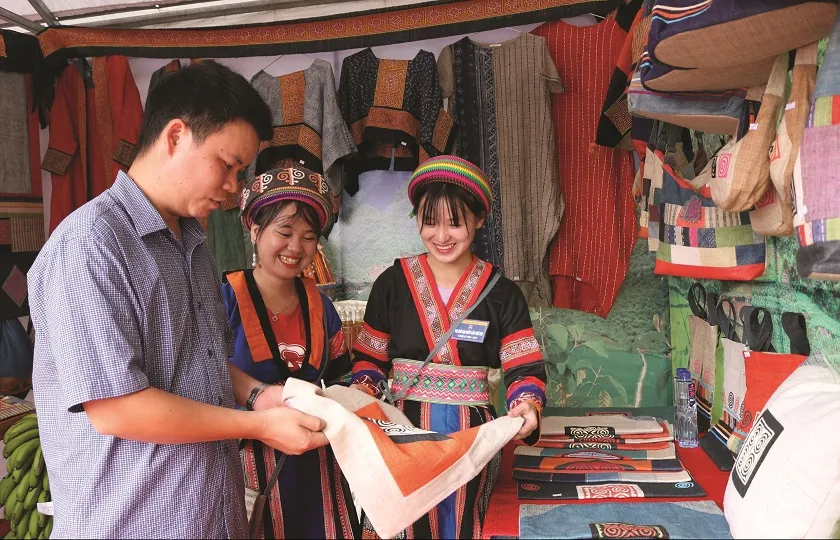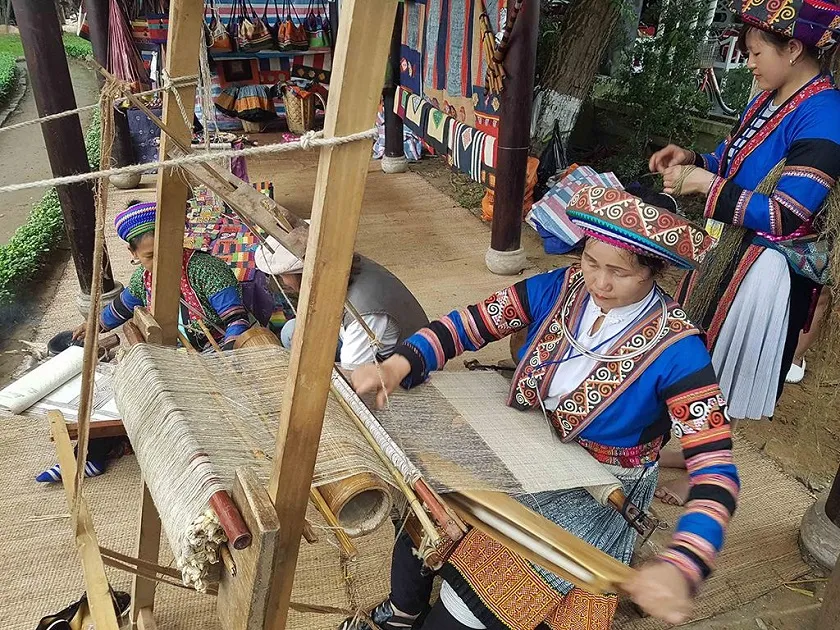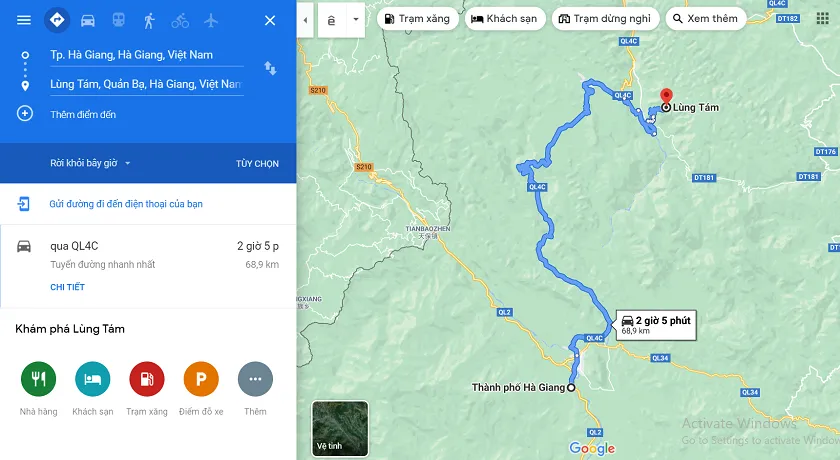Ha Giang, the northernmost province of Vietnam, is renowned not only for its majestic mountains, golden terraced rice fields during harvest season, and winding, challenging mountain passes. This land also harbors unique traditional cultural values, preserved and developed through generations. Among them, Lung Tam linen weaving village, located in Quan Ba district, stands out as a bright spot, attracting visitors with its rustic beauty, simplicity, and exquisite linen products imbued with the Mong ethnic identity. Join “Du lịch khắp thế gian” (Travel Around the World) to explore the fascinating aspects of this special village on your Ha Giang journey.
Introducing Lung Tam Weaving Village: Preserving the Soul of Mong Linen
Lung Tam village, a small, peaceful village nestled at the foot of Quan Ba Twin Mountains, about 50km from Ha Giang city center, is home primarily to the Mong ethnic people. It is known as one of the most famous traditional linen weaving cradles in Ha Giang. Linen weaving in Lung Tam is not just a simple handicraft; it is an integral part of the cultural and spiritual life of the local people. According to the elders in the village, linen weaving has existed in Lung Tam for a very long time, passed down from generation to generation, becoming a unique cultural beauty and a source of pride for the people of Lung Tam.

Peaceful scenery at Lung Tam linen weaving village, Ha Giang
Coming to Lung Tam, visitors will feel the difference compared to other famous silk weaving villages. It is not noisy or bustling, but possesses a pure, rustic beauty, harmonizing with the mountainous nature. Simple earthen wall houses, winding small roads, and the rhythmic sounds of looms echoing in the quiet space all create a peaceful, highland-style village scene.
Exploring the Unique Linen Weaving Process in Lung Tam: From Flax Plant to Brocade Fabric
The linen weaving process of the Mong people in Lung Tam is a meticulous and elaborate handicraft, requiring the skill, patience, and dedication of the artisans. From planting flax, harvesting, to spinning yarn, weaving fabric, dyeing, and creating patterns, each stage is done entirely by hand, following traditional methods passed down through many generations.
To begin the linen weaving process, Mong women select good fields to plant flax. After about two months of care, when the flax plants reach a certain maturity, they proceed to harvest. After harvesting, the flax is brought back to peel off the bark and dry. The process of peeling flax bark and extracting fibers requires skill and experience to ensure the flax fibers are long, even, and unbroken.
The raw flax fibers, after being spun, undergo a boiling process in ash lye and beeswax. The purpose of boiling the yarn is to soften the flax fibers, making them easier to weave and increasing the durability of the product. After boiling, the flax fibers are washed and ready for the weaving stage.

The skillful hands of Mong women create exquisite linen fabrics
The weaving stage is carried out on traditional wooden looms. Weavers must sit for hours at the loom, their hands skillfully moving the shuttle, creating even and firm fabric lines. The diligence, meticulousness, and skillful hands of Mong women have transformed raw flax fibers into rustic linen fabrics, deeply imprinted with cultural identity.
A special feature in the Lung Tam linen weaving process is the natural dyeing and pattern creation technique. Dyes are extracted from available plants and forest leaves in nature, such as indigo leaves, yam roots, and tree bark. Patterns on Lung Tam linen fabric are often traditional motifs imbued with Mong cultural identity, meticulously and exquisitely drawn with molten beeswax. The beeswax drawing technique not only creates unique patterns but also helps protect the dye color and increase the durability of the product.
Cultural and Spiritual Values of Lung Tam Linen Weaving: The Soul of the Mong Ethnic Group
Linen weaving not only provides a stable income for the people of Lung Tam but also contains profound cultural and spiritual values. For the Mong people, linen fabric is not just ordinary clothing but also carries special spiritual significance. According to Mong beliefs, linen fabric is a connection between the yin and yang worlds, a bridge guiding the deceased to their ancestors and reincarnation as humans. Therefore, linen fabric plays an important role in Mong traditional rituals and customs, from weddings and funerals to important festivals.

Tourists interested in traditional Mong costumes at Lung Tam village (Source: Vntrip)
In traditional Mong society, linen weaving is also a measure of a woman’s virtue. A Mong woman skilled in linen weaving is considered a capable, skillful, diligent, and hardworking daughter. Therefore, from a young age, Mong girls are taught by their mothers and grandmothers how to plant flax, spin yarn, and weave fabric. Linen weaving is not just a livelihood but also part of the process of growing up, affirming the value of Mong women in the family and community.
Today, with the development of tourism, Lung Tam linen fabric is not only used to make traditional costumes but has also been transformed into many diverse products to serve the needs of tourists, such as tablecloths, bags, scarves, and souvenirs. Products from Lung Tam linen fabric not only have high aesthetic value but are also meaningful gifts, expressing respect for traditional culture and support for the handicraft of local people.
Tourist Experiences at Lung Tam Weaving Village: Immersing Yourself in Unique Cultural Space
Coming to Lung Tam linen weaving village, visitors not only admire the beauty of exquisite linen products but also have the opportunity to experience many interesting activities and explore the unique cultural beauty of the Mong people. Visitors can visit weaving workshops, witness firsthand the manual linen weaving process, from spinning yarn to weaving fabric, dyeing, and creating patterns.
Visitors can also interact and chat with weavers, listen to stories about the craft, culture, and life of the people of Lung Tam. The friendliness, openness, and sincerity of the local people will surely leave a deep impression on visitors.
In addition, visitors can try their hand at simple linen weaving steps or participate in short linen weaving classes to better understand this traditional craft. This is an interesting and meaningful experience, helping visitors not only discover culture but also contribute to preserving and developing the traditional linen weaving craft of Lung Tam.

Experiencing linen weaving, a fun activity for tourists in Lung Tam (Source: Phu Tho Photo Newspaper)
When visiting Lung Tam, don’t forget to visit souvenir shops and choose unique linen products for yourself, such as scarves, bags, clothes, or decorative items. These will be meaningful gifts to give to loved ones, friends, or to keep as souvenirs of your Ha Giang trip.
Directions to Lung Tam Weaving Village: Journey to Explore the Highlands
The road to Lung Tam linen weaving village is not too difficult, but it also requires visitors to be prepared and careful. From Ha Giang city center, visitors can travel by motorbike or car along National Highway 4C towards Quan Ba. Arriving at Quan Ba Heaven Gate, continue through Tam Son town to Coc Ma village. At Coc Ma village, pay attention to turn right at the 7th intersection and go straight along the small road to Lung Tam village.

Directions to Lung Tam linen weaving village from Ha Giang center
For convenient travel and exploration of Lung Tam as well as other tourist attractions in Ha Giang, visitors should choose motorbikes as a means of transportation. Renting motorbikes in Ha Giang is quite easy and affordable. However, visitors should remember to fill up with gas, check the vehicle carefully before departure, and drive safely on steep mountain roads.
In addition, visitors can also combine visiting Lung Tam linen weaving village with other famous tourist attractions in Quan Ba and Ha Giang, such as Quan Ba Twin Mountains, Quan Ba Heaven Gate, Dong Van Karst Plateau Geopark, Lung Cu flagpole… to have a complete and memorable Ha Giang exploration journey.
Lung Tam Village Travel Tips: Useful Notes
To make your visit to Lung Tam linen weaving village more complete and meaningful, “Du lịch khắp thế gian” (Travel Around the World) would like to share some useful tips:
- Ideal time to visit: Visitors can come to Lung Tam at any time of the year. However, the best time to travel to Ha Giang in general and Lung Tam in particular is in spring (February – April) and autumn (September – November). In spring, visitors will admire the brilliant beauty of peach blossoms and plum blossoms blooming throughout the mountains and forests. Autumn is the time when rice ripens in golden terraced fields, creating an extremely poetic and charming scene.
- Clothing: You should choose comfortable, neat clothing suitable for travel and sightseeing. If traveling in winter, bring warm clothes, scarves, and hats because the weather in Ha Giang is quite cold. Visitors can also rent traditional Mong costumes for souvenir photos.
- Food and drink: When you come to Ha Giang, don’t forget to enjoy the famous specialties of the highlands, such as Thang Co (horse meat hotpot), Men Men (steamed corn flour), Chao Au Tau (Au Tau porridge), Thit Trau Gac Bep (smoked buffalo meat), Banh Cuon Trung (egg rolled rice pancakes)… In Quan Ba, visitors can enjoy the seedless persimmon specialty around August – October.
- Shopping: In addition to products from Lung Tam linen fabric, visitors can buy other Ha Giang specialties as gifts, such as mint honey, corn wine, Lap Xuong (Vietnamese sausage), and “Cap Nach” pork (pig raised in the armpit style).
Lung Tam linen weaving village is not only an attractive tourist destination but also a place to preserve the precious traditional cultural values of the Mong ethnic group. Coming to Lung Tam, visitors will have the opportunity to discover the rustic beauty of the highland countryside, learn about the unique linen weaving process, and immerse themselves in the cultural space rich in national identity. Come and feel the beauty of Lung Tam on your Ha Giang exploration journey!